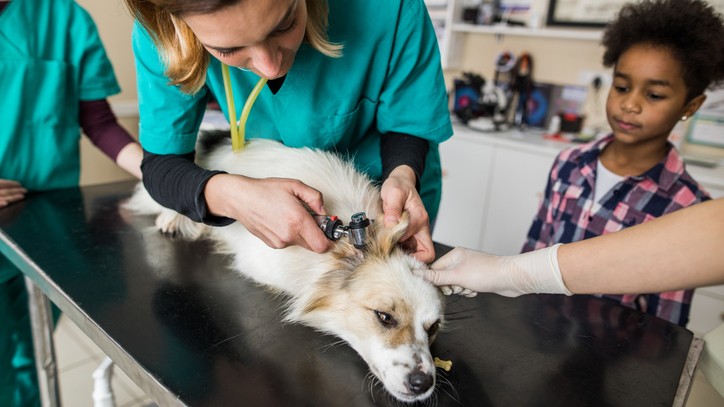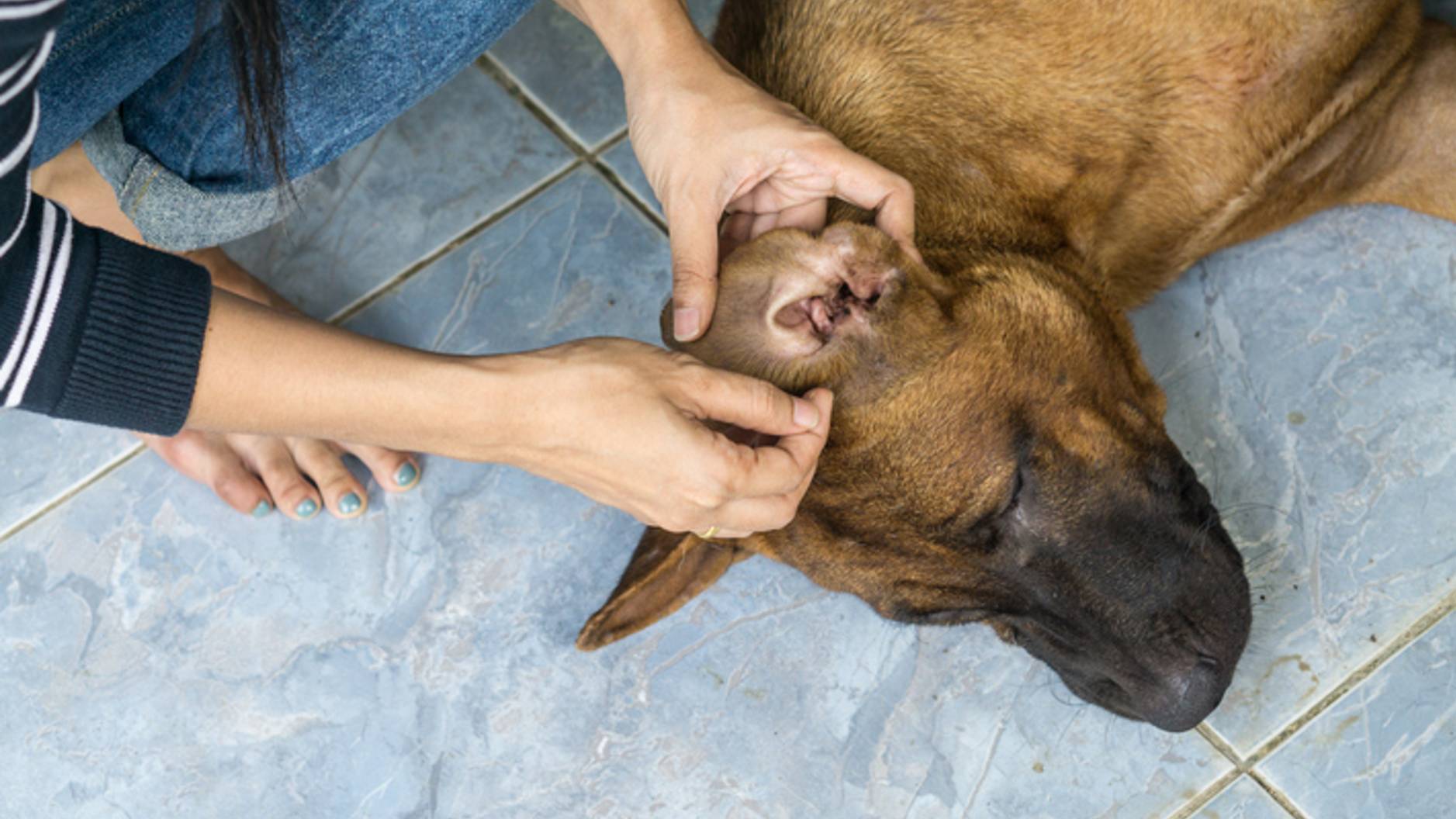Ear infections in dogs: Vet's guide to causes and treatment
Ear infections in dogs can be frustrating. Know the symptoms, causes and ways to treat them according to a vet

Ear infections in dogs are one of the most common problems presented to vets, making up about 5% of a vet’s caseload. They may be common, but they’re frustrating to treat due to the myriad things that they can be caused by.
Ear infections can also cause lasting damage when untreated. Whilst antibiotic ear drops from the vet will treat most ear infections, getting to the bottom of what’s causing the ear infections is the only way to stop them from coming back for good.
Symptoms of ear infections in dogs
Knowing the symptoms of an ear infection is important. Have you been wondering, why is my dog shaking their head? Perhaps they're scratching their ear or rubbing their head on the ground? They may have an infection. If you take a closer look, you might be able to see that the skin on the underside of the earflap is hot, red, or swollen.
There may be more wax than usual, or a different coloured wax. In addition, ear infections often smell. If your dog has any of these symptoms, getting them to the vet to get the infection diagnosed and treated is a good idea, as delay can cause further problems.

Causes of ear infections in dogs
Dogs don’t generally get ear infections for no reason, just as it’s rare for an adult human to get an ear infection. When a dog gets an ear infection, there’s almost always an underlying cause.
Whilst it’s important to treat the infection, it’s also a good idea to do further testing to get to the root cause of the problem, otherwise it’s likely to be a recurrent issue. These are some of the most common causes of an ear infection in dogs.
1. Allergies
By far the most common cause of ear infections is ‘atopic dermatitis’, or allergies. Allergies cause skin inflammation, and this allows normal bacteria and yeasts in the ear to grow and do more damage than they would do normally.
And the more damage they do, the more attractive your dog’s ear becomes to other bacteria. Over time, this cycle of damage causes permanent damage to the ear.
2. Foreign body
Sometimes, something happens to bring so many bacteria into your dog’s ear that the natural mechanism to keep them in check can’t keep up.
A foreign object, such as a grass seed, can get lodged in your dog’s ear, carrying with it huge numbers of bacteria. Whilst the irritation of a grass seed is often noticeable before the infection has got going, some severe, recurrent infections are found to be due to an old grass seed.

3. Anatomy
Not all ears are the same. We’ve bred dogs to have floppy ears, pricked ears, hairy ears – and sometimes, these changes make them more likely to have ear infections. Very hairy ears (often found in poodles and poodle crosses such as cockerpoos) can trap ear wax, causing an excessively moist ear, perfect for fungal overgrowth.
Sometimes, the ear canal is shaped in such a way that ear infections are more common. Small tumours and other growths can also block the canal, causing problems.
4. Swimming
‘Swimmer’s Ear’ can affect dogs, too. Regular swimming that moistens the ear canal can create the right environment for yeasts to grow.
Whilst these infections are rarely as severe as that of a foreign body or allergy, they can still be uncomfortable, causing ongoing inflammation and large amounts of wax, which can be irritating for dogs. If your dog is a regular swimmer you should consider whether this is contributing to their problem.

Treating dog ear infections
If your veterinarian suspects an ear infection, they'll check for underlying causes. They'll look down the ear with an instrument called an otoscope, which will allow them to look for any seeds or other foreign material. It will also help them check the shape of the ear canal and whether the eardrum is intact. They'll look for other areas of itchy or inflamed skin that could indicate an allergy.
They'll also take a complete history, asking plenty of questions about your dog's lifestyle and how you care for your dog's ears at home. They'll probably take a sample of the wax and use a microscope to check which type of bacteria or yeast is causing the infection. They might also suggest sending a sample to the lab. These tests will help your vet to choose the best antibiotic drops for your dog’s particular infection. With the right treatment and a good cleaning regime, most ear infections clear up quite quickly.
However, in more persistent cases, your dog might need to have their ears syringed under anaesthetic. In very extreme situations where a dog's ear canal has become so narrow that the infection can't be treated, your veterinarian might need to perform surgery to alter the shape of the ear canal or remove diseased tissue.
Will a dog ear infection go away on its own?
If your dog has an ear infection, you might wonder if it might go away without treatment. After all, if your dog is prone to ear problems, it might be tempting to try to avoid yet another trip to the vet. However, if the ears are infected, rather than just dirty, they won't get better on their own.
Instead, the infection is likely to linger, gradually worsening and causing your dog more and more pain. So, if your dog is scratching at their ears, or they are red, smelly, or waxy, you shouldn't ignore the signs. If left untreated, ear infections can spread deeper into the ear canal and cause swelling and scarring. Over time this can cause the ear canal to become permanently narrower, meaning your pooch might suffer from hearing loss.

Preventing canine ear infections
If your dog suffers with ear infections, you’re probably fed up of them. They’re irritating for your dog, and they’re irritating for you. Fighting to apply ear drops is probably affecting your relationship with your dog and you’re desperate to find something that can fix the problem once and for all. So, does such a cure-all exist?
Unfortunately, it’s not as simple as a ‘magic powder’ or ‘cure-all cream’ that will keep your dog ear-infection free. Life is rarely that simple. But hopefully these tips will help!
1. Ask your vet for help
Try to book a slot with your vet to talk about your dog’s ear infections – you may not even need to take your dog. Make a plan together to get to the bottom of what is bothering your dog rather than treating the ear infections over and over again.
2. Stop your dog from swimming
If your dog is a swimmer, it’s possible this is contributing to their ear problems. Try stopping swimming and see if that helps. If you can stop swimming for eight weeks and your pet’s problems go away, you have some evidence that swimming is causing it. You can then talk to your veterinarian about home care for your dog’s ears. There are ear drops specifically designed as a preventative for dogs who like to swim – your vet may recommend these to you, along with a home-care regime.
3. Try feeding your dog an elimination diet
Allergies are the single most common cause of ear infections. And, whilst most allergies are to pollen and things in the environment, 1 in 10 are to a protein in the food – and food allergies are more likely if your dog also has occasional gastric upset such as runny stool, excessive gas, or a noisy belly.
Dogs don’t have to have had a recent food change for food to be the cause of their ear problems – in fact, allergies develop over time, generally after several weeks’ exposure to the protein.
An elimination diet involves feeding a hydrolysed protein for eight weeks. If your dog improves in that time, but gets worse again following returning to their old diet, you know food is the cause, and you can then work with your vet to determine which proteins are upsetting your dog. You could also take a look at our list of the best dog food for allergies.

4. Go to the groomer
If your vet diagnoses your dog with excessively hairy ears, ear plucking may help. Don’t rush off to the groomer without talking to your vet, though – in many cases, plucking can make the ears worse. Your groomer and vet can work together to determine the best ear plucking regime for your dog. We offer some advice on the best dog grooming kit in our buying guide.
5. Diagnose environmental allergies
If your pet still isn’t better after trying the above, thinking about environmental allergies may be a good idea. Allergen testing can be done to help you work out what is wrong. Common allergens include pollens, trees, fleas and house mites, all things that are difficult or impossible to avoid. Instead, your veterinarian can get medications for your dog.
‘Vaccinations’ against the allergens can help around two out of three dogs – tiny amounts of allergen are injected into your dog to teach them to tolerate the allergen. Your vet will need to organise this for you after your dog’s allergy test results are returned.
Conclusion
Ear infections in dogs are complex, and no two dogs are the same. It can be tricky to get to the bottom of your dog’s ear problem, but doing so is essential to prevent them from occurring. Follow our five tips from a vet to prevent and cure your dog’s ear infections.
PetsRadar Newsletter
Get the best advice, tips and top tech for your beloved Pets
After graduating as a vet from the University of Nottingham, Dr Joanna Woodnutt went on to practice companion animal medicine in the Midlands. Since then, she has also written for countless online and print publications and is a regular contributor for Edition Dog Magazine.

